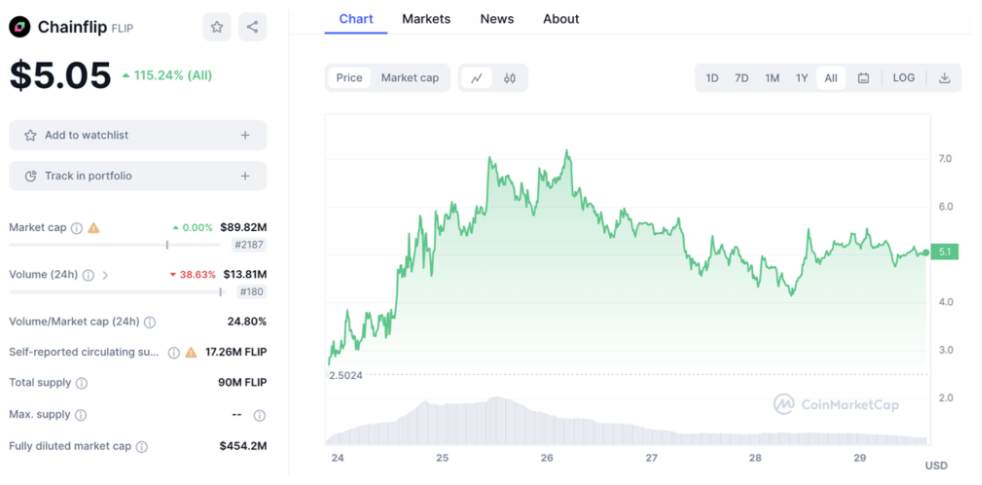MT Capital Insight: Chainflip - A New Competitor in the Native Cross-Chain Exchange Market
Author: Severin, MT Capital
TL;DR
- Chainflip enables native cross-chain value conversion with higher decentralization, security, and composability.
- The $FLIP token will remain inflationary in the short term, and we expect that the token buyback and burn from trading volume will not be sufficient to push $FLIP into deflation.
- Chainflip offers a better product experience and design compared to Thorchain, but Thorchain has first-mover advantages such as high market awareness and market share. Therefore, we predict that Chainflip will struggle to completely replace Thorchain in the short term.
- Chainflip has a market cap of approximately $90M, with a fully diluted market cap of about $460M. Thorchain has a market cap of $2.1B and a fully diluted market cap of $3B. From a comparable valuation perspective, $FLIP still has nearly 8x potential. However, Thorchain's market cap is supported by its total trading volume of $68B and recent daily trading volume of over $100M, while Chainflip has yet to generate any trading.
- We will remain cautiously optimistic about the future performance of $FLIP and will pay special attention to whether Chainflip's recent mainnet launch incentive program can significantly boost trading volume.
Chainflip: A Decentralized Cross-Chain Liquidity Network
Native Cross-Chain Value Conversion
Unlike cross-chain solutions that use wrapped assets or require minting/burning assets in the intermediate process, Chainflip opts for a native cross-chain value conversion method.
This means that on each chain supported by Chainflip, there is a liquidity native asset pool, forming a cross-chain universal settlement layer to meet users' needs for cross-chain asset conversion. The advantages of native cross-chain value conversion include:
Value conversion is independent of chains and wallets; Chainflip allows users to use regular wallets for value conversion across any chain.
Value conversion does not involve any wrapped assets, synthetic assets, or other assets; users only need to submit a regular transaction for the exchange, and after the exchange is completed, they will not face any additional asset risks.
Chainflip does not require additional deployment or execution of other protocols on specific chains, offering higher compatibility and universality, while minimizing on-chain computation to reduce users' gas costs.
Chainflip's native cross-chain value conversion method lowers the operational threshold for users, reduces their risk exposure, and provides a better user experience.

source: Image Source
Decentralization
Compared to other solutions, another major advantage of Chainflip is its higher degree of decentralization. Chainflip's validation network consists of up to 150 validator nodes. Validator nodes will maintain network security, participate in consensus, monitor external chain events, and jointly control system funds. The process of becoming a validator node is also permissionless; users only need to stake enough $FLIP and win the auction with the highest bid to become one. The core idea of Chainflip is to use MPC (Multi-Party Computation), particularly TSS (Threshold Signature Scheme), to create an aggregation key held by a permissionless network of 150 validators. All operations and state changes in Chainflip require confirmation from more than 2/3 of the nodes to ensure higher security. Compared to cross-chain value exchange on centralized exchanges and some highly centralized cross-chain bridges, users do not need to worry about the malicious risks of centralized exchanges and centralized servers of cross-chain bridges. Chainflip avoids single points of failure and malicious risks from individual nodes through higher decentralization, significantly enhancing the overall security of the system.
 source: Image Source
source: Image Source
JIT AMM
The computation process for cross-chain value conversion is accomplished by Chainflip's Just In Time AMM (JIT AMM) built on a state chain based on Substrate. JIT AMM is built on Uni V3, but unlike Uni V3, JIT AMM is not a series of smart contracts on different chains; it performs virtual calculations for value conversion solely on the state chain. That is, Chainflip's accounting and computation functions are executed off-chain, while the underlying settlement relies on the treasury set up by Chainflip on various chains. This workflow greatly simplifies the operational complexity of executing cross-chain value exchange calculations, accounting, and settlement across different chains, effectively reducing users' gas costs. Additionally, Chainflip's state chain can support more customized needs for JIT AMM. For example, Chainflip allows LPs to update limit orders dynamically and promptly based on incoming order quotes, preventing MEV bots from front-running trades through LP competition, improving the capital efficiency of LPs, and enabling users to obtain better market prices with lower slippage.

source: Image Source
Composability
Compared to existing cross-chain bridges, Chainflip also offers better composability. Developers can easily integrate Chainflip's native cross-chain value exchange functionality into existing protocols or products through the Chainflip SDK. Just as Uniswap's Swap function has been widely integrated into DeFi use cases, higher composability will bring more use cases to Chainflip. With the current explosion of highly composable use cases represented by full-chain games, as application-layer Lego blocks continue to stack, it will inevitably stimulate users' demand for underlying asset liquidity across multiple chains. However, the current situation is that the liquidity divide between L1 and L2 is becoming increasingly severe, and native cross-chain value exchange solutions represented by Chainflip may become an essential embedded feature for multi-chain projects.
Team Background
The Chainflip team consists of 26 experienced global talents. Simon Harman is the founder and CEO of Chainflip and is also a board member of the Oxen Foundation. Before Chainflip, Simon led the team to develop products including the messaging application Session based on the Signal protocol. CTO Martin was previously the founder of Covariant Labs and the CTO and CSO of Finoa. The Chainflip team has a rich crypto background, with nearly 60% of the personnel being developers, resulting in a high-quality overall team composition.
Token Economics Model
On November 23, 2023, Chainflip announced the launch of its mainnet and the issuance of the $FLIP token. After its issuance, $FLIP quickly gained popularity in the market, currently priced at around $5, representing an increase of nearly 2.7x from the ICO price of $1.83.
$FLIP is Chainflip's native ERC-20 token, with an initial supply of 90M, following a dynamic token supply model. Currently, Chainflip expects an annual token inflation of 8% to incentivize validator nodes. Additionally, Chainflip's transaction fees will also be used to buy back and burn $FLIP, potentially leading to a deflationary state for $FLIP. The token utility of $FLIP is primarily reflected in its use for staking validation and value capture within the protocol.

source: Image Source
$FLIP Staking Validation
Like most validation networks, since the 150 Chainflip nodes will control all system funds and operations, to avoid malicious behavior, nodes must stake a sufficient amount of $FLIP as a penalty to participate in validation. Nodes that stake more $FLIP have a higher chance of becoming authoritative validator nodes and thus receive additional validation rewards.
Currently, it is expected that an annual token reward of 7% will be evenly distributed among authoritative validator nodes. Ordinary backup validator nodes will also receive an annual token reward of 1% based on the proportion of staked $FLIP. Therefore, it is evident that the amount of $FLIP staked will significantly impact the validation rewards of validator nodes, amplifying the demand for holding and staking $FLIP tokens. Chainflip also expects the staking rate of $FLIP to account for 37%-66% of the total supply, and significant token staking will help maintain token price stability and reduce market selling pressure.

source: Image Source
$FLIP Value Capture
For every token exchange conducted through Chainflip, Chainflip will charge a 0.1% fee. This fee will be collected in USDC and used to purchase $FLIP. The purchased $FLIP tokens will be directly burned. Similarly, gas fees on the state chain will also be used to buy $FLIP and burn it. Chainflip aims to reflect the value generated by the protocol dynamically in the price of $FLIP through the token buyback and burn mechanism, rewarding $FLIP holders and enhancing the value capture capability of $FLIP. Of course, due to the inflation of $FLIP itself, Chainflip also needs to achieve sufficient daily trading volume for its token buyback and burn to drive up the price of $FLIP.
Future Expectations
Potential Market
With the continuous launch of numerous L1 and L2 solutions, the liquidity divide between chains is becoming increasingly severe. According to DeFiLlama data, there are a total of 71 chains with a TVL of over $10M. The rise of Rollup as a Service and application chains will further exacerbate the liquidity divide issue. Traditional cross-chain bridges, which frequently encounter hacking issues, are no longer the first choice for users seeking cross-chain liquidity. Native cross-chain token exchange solutions represented by Thorchain and Chainflip may become mainstream. Currently, the cumulative value on cross-chain bridges is approximately $12B, while Thorchain's TVL is only about $300M, indicating that native cross-chain token exchange solutions still have tens of times the market space.
Comparison with Thorchain
Overall, Chainflip's market positioning is quite similar to that of Thorchain, but there are some differences in product usage experience and design:
- Product Experience: Thorchain requires a separate multi-chain wallet, while Chainflip only needs a regular on-chain wallet for use, providing a more convenient user experience. Of course, Thorchain is currently working on compatibility with mainstream wallets to gradually bridge the wallet experience gap.
- Degree of Decentralization: Thorchain currently has 104 nodes maintaining the security of the on-chain treasury, while Chainflip's decentralized validation network consists of 150 nodes. In terms of the number of nodes, Chainflip has a relatively higher degree of decentralization, but there is no significant difference between the two.
- Product Design: Thorchain's liquidity pools and token exchanges rely on $RUNE as an intermediary, while Chainflip does not depend on any specific token. Therefore, Chainflip's liquidity pools and token exchange processes are not exposed to the risks of any specific token, providing relatively higher security.

source: Image Source1 & Image Source2
In summary, Chainflip currently offers a slightly better user experience, degree of decentralization, and security compared to Thorchain, but Thorchain's first-mover advantage, market awareness, and market share are also significant competitive advantages. Therefore, we predict that Chainflip will struggle to completely replace Thorchain in the short term. It is more likely that, as stated in Thorchain's official tweets, Chainflip will continuously erode the market share of cross-chain bridges alongside Thorchain.

source: Image Source
Currently, Chainflip has a market cap of approximately $90M, with a fully diluted market cap of about $460M. Thorchain has a market cap of $2.1B and a fully diluted market cap of $3B. From a comparable valuation perspective, $FLIP still has nearly 8x potential. However, Thorchain's market cap is supported by its total trading volume of $68B and recent daily trading volume of over $100M, while Chainflip has yet to generate any trading. Therefore, we will remain cautiously optimistic about the future performance of $FLIP and will pay special attention to whether Chainflip's recent mainnet launch incentive program can significantly boost trading volume.
Reference
MT Capital
MT Capital, headquartered in Silicon Valley, is a crypto-native fund focused on Web3 and related technologies. We have a global team with diverse cultural backgrounds and perspectives, allowing us to gain deep insights into global markets and seize investment opportunities in different regions. MT Capital's vision is to become a leading global blockchain investment firm, focusing on supporting early-stage technology companies that can generate significant value. Since 2016, our investment portfolio has covered various fields, including Infra, L1/L2, DeFi, NFT, and GameFi. We are not just investors; we are the driving force behind the founding teams.









